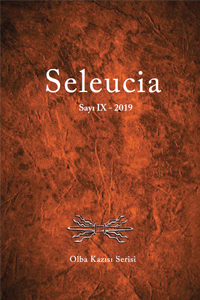Silifke Müzesi’nden Erken Bizans Dönemine Ait Gümüş Tılsım
Geç Antik ve Orta Çağ’da doğaüstü güçlerden yardım beklenerek tılsımlar kullanılmıştır. Tılsım geleneğinin kökeni, Mısır ve Mezopotamya’ya dayanır ve Hıristiyanlığın yayılmasından sonra da devam etmiştir. Tılsımlar üzerinde pagan figürlerin yanı sıra Hıristiyan inancıyla ilişkili figür, şekil ve yazılarda görülür. Örneğin Atlı Kahraman, dişi şeytan Gyllou’yu öldürür, Kem göz Eski çağlarda kullanıldığı gibi Orta çağlarda Pagan, Yahudi ve Hıristiyanlar arasında da kullanılmıştır. Silifke Müzesi’nde sergilenen gümüş tılsım üzerinde Kutsal Binici tasvir edilmiştir. Kutsal Binici, Hz. Süleyman, Aziz Sisinnios ya da başka bir aziz olmalıdır. Kutsal Binicinin yerdeki dişi şeytanı öldürme anı gösterilmiştir. Lilith/Gyllou doğum yapmış kadınlara ve yeni doğmuş bebeklere düşmandır. Özellikle bu tür amuletler, bebek ölümlerini, engellemek ve kadınları jinekolik hastalıklardan koruma amacıyla kullanılmıştır.
Silifke Müzesi’nden Erken Bizans Dönemine Ait Gümüş Tılsım
The amulets which were used in order to ask the supernatural powers for help were common especially in Late Ancient Time and the Middle Age. It seems that the tradition of doing magic and spell which dates back to the time of Mesopotamia and Egypt continued after the emerge and the spread of Christianity. Symbolic figures, images, scriptures, and religious designs which were related to Christian belief were used besides Pagan figures. To exemplify, figures like The Hero Rider killing the Gyllou/Satan, Medusa’s Head, The Much-Suffering Eye, and the like were used in Early Ancient Time and the Middle Age by the people of Pagan, Jewish, and Christian. Moreover, Holy Rider was described on the silver amulet which is displayed in the Museum of Silifke. The figure of saint rider is about to spear into The Female Satan who is lying on the ground. Here, Solomon, Sissinios, or one of other saints other might have been described. Lilith/Gyllou, who is The Female Satan, is an enemy of women who have just gave a birth and newborn babies; therefore this amulet may have been used in order to protect women from gynaecological diseases and babies from dying
___
- Aubert 1989 J.J. Aubert, “Threatened Wombs: Aspect of Ancient Uterine Magic”, Greek-Roman and Byzantine Studies 30.
- Bonner 1950 C. Bonner, Studies in Magical Amulets, Chiefly Graeco-Egyptian, Ann Arbor. Bouras 1985
- L. Bouras, “Medusa Amulet”, Byzantine and Post Byzantine Art, Athens. Cutler 1997
- A. Cutler, “Art in Byzantine Society: Motive Forces of Byzantine Patronage”, Imagery and Ideology in Byzantine Art, Variorum, Hampshire. Dafi 2012
- E. Dafi, “A Byzantine Lead Amulet from Samos”, Byzantine Small Finds in Archaeological Contexts, Byzas 15, eds. B. Böhlendorf-Arslan ve A. Ricci. Dalton 1901
- O.M. Dalton, Catalogue of Early Christian Artifacts and Objects from the Christian East in the British Museum, London. Dalton 1924
- O.M. Dalton,, “A Gold Pectoral Cross and Amuletic Bracelets of the Sixth Century”, Melanges Offerts am G. Schlumberger II, Paris. Davidson 1952
- G.R. Davidson, Corinth, The Minor Objects, Result of the Excavations, New Jersey-Princeton. Demirci 2013
- K. Demirci, Eski Mezopotamya Dinlerine Giriş, İstanbul. Grabar 1970
- A. Grabar, “Deux portails sculptés paléochrétiens d’Egypte et d’Asie Mineure, et les portails Romans”, Cahiers Archaéologiques XX. Gregory 1991
- T.E. Gregory, “Gnostisizm”, The Oxford Dictionary of Byzantium II. Heintz 2003
- M. Fulghum Heintz, “Health”, Byzantine Women and Their World, Ed. I. Kalavrezou, Harvard University Press, Cambridge. Maguire 1995
- H. Maguire, “Magic and Christian Image”, Byzantine Magic, (ed. H. Maguire), Harvard University Press, Washington D.C. Maguire 1998 (a)
- H. Maguire, “Magic and Geometry in Early Christian Floor Mosaics and textiles”, Rhetoric, Nature and Magic in Byzantine Art, Ashgate/ Variorum, Aldershot. Maguire 1998 (b)
- H. Maguire, “The Cage of Crosses: Ancient and Medieval sculptures on the ‘Little Metropolis’ in Athens”, Rhetoric, Nature and Magic in Byzantine Art, Ashgate/Variorum, Aldershot. Mango 1986
- M. Mundell Mango, Silver From Early Byzantium, The Kaper Koraon and Related Treasure, Baltimore - Maryland. Mango 2002
- C. Mango, “New Religion, Old Culture”, The Oxford History of Byzantium, Ed. C.Mango, Oxford. Piccirillo 1997
- M. Piccirillo, The Mosaics of Jordan, Amman. Robinson 1953
- D.M. Robinson, “A magical inscription from Pisidian Antioch”, Hesperia 22/3.
- Russell 1999 J.B. Russell, İblis, Erken Dönem Hıristiyan Geleneği, Kabalcı Yayınevi, İstanbul.
- Russels 2000 J. Russels, “Household furnishings”, Antioch, The Lost Ancient City, ed. C. Kondoleon, Princeton University Press. Taft 1991
- R.F. Taft, “Trisagion”, The Oxford Dictionary of Byzantium 3. Trzcionka 2007
- S. Trzcionka, Magic and the Supernatural in Fourth-Century Syria, Routledge, London-New York. Unterman 1997
- A. Unterman, “Amulets”, Dictionary of Jewish Lore and Legend, London. Vikan 1984 G. Vikan, “Byzantine Art, Medicine and Magic in Early Byzantine Age”, Dumbarton Oaks Papers 38.
- Vikan - Mango 1991 G. Vikan - M. Mundell Mango, “Votives”, The Oxford Dictionary of Byzantium 3 (1991), 2186 - 7. Walter 2000
- C. Walter, “The Intaglio of Solomon in the Benaki Museum and the Origins of the Iconography of Warrior Saints”, Pictures as Language. How the Byzantines Exploited Them, London. Walter 2000
- C. Walter, “Some Unpublished Intaglios of Solomon in the British Museum, London”, Pictures as Language. How the Byzantines Exploited Them, London.
- Walter 2003 C. Walter, The Warrior Saints in Byzantine Art and Tradition, Ashgate, Cornwall.
- ISSN: 2148-4120
- Başlangıç: 2011
- Yayıncı: Bilgin Kültür Sanat Yayınevi
Sayıdaki Diğer Makaleler
Olba Kazılarından Küçük Buluntular
Olba Kazısı Kiremit Örnekleri Arkeometrik Çalışmaları
Ali Akın AKYOL, Ebru ERDOĞAN YILDIRIM, Emel ERTEN, Yusuf Kağan KADIOĞLU
Artuklu Türkmenleri’nin Sikkelerinde Mitolojik Bir Yaratık: “Çift Başlı Kartal”
Bizans Sikkelerinde Başmelek Mikhail ve Aziz Mikhail Tasvirleri
Klaros Kasesi ve Anadolu’da Pers Egemenlik Döneminde Cam Kase Üretimi Konusunda Düşünceler
Anadolu’da Kadın: On Bin Yıldır Eş, Anne, Tüccar, Kraliçe
Genius Loci: Towards a Roman Understanding of Carthage
Erken Hıristıyanlık Döneminde Cilicialı Şifavericiler: Dioscorides, Cosmas ve Damianus
